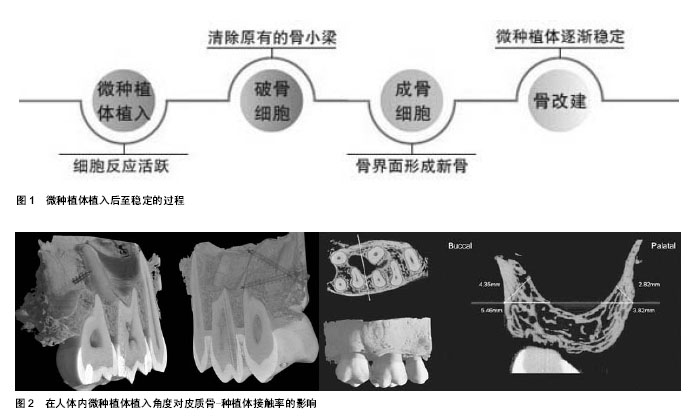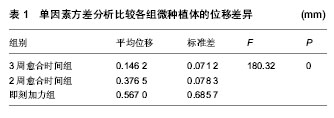| [1] Leung MT,Lee TC,Rabie AB,et al.Use of miniscrews and miniplates in orthodontics . J Oral Maxillofac Surg.2008; 66(7):1461-1466.
[2] Carano A,Velo S,Leone P,et al.Clinical applications of the miniscrew anchorage system.J Clin Orthod.2005;39(1):9-24.
[3] Papageorgiou SN,Zogakis IP,Papadopoulos MA.Failure rates and associated risk factors of orthodontic miniscrew implants: a meta-analysis.Am J Orthod Dentofacial Orthop.2012;142(5): 577-595.e7.
[4] Schätzle M,Männchen R,Zwahlen M,et al.Survival and failure rates of orthodontic temporary anchorage devices: a systematic review. Clin Oral Implants Res.2009;20(12):1351-1359.
[5] Oltramari-Navarro PV,Navarro RL,Henriques JF,et al.The impact of healing time before loading on orthodontic mini-implant stability: A histomorphometric study in minipigs. Arch Oral Biol.2013;58(7):806-812.
[6] Janson G,Gigliotti MP,Estelita S,et al.Influence of miniscrew dental root proximity on its degree of late stability.Int J Oral Maxillofac Surg.2013;42(4):527-534.
[7] Motoyoshi M,Inaba M,Ono A,et al.The effect of cortical bone thickness on the stability of orthodontic miniimplants and on the stress distribution in surrounding bone.Int J Oral Maxillofac Surg.2009;38(1):13-18.
[8] Xu Z,Zhao L,Wu Y,et al.Histomorphometric and biomechanical analyses of the osseointegration of loaded orthodontic microscrews inserted at different cortical bone thickness sites.Oral Surg Oral Med Oral Pathol Oral Radiol. 2014;118(2):157-165.
[9] Lim JE,Lee SJ,Kim YJ,et al.Comparison of cortical bone thickness and root proximity at maxillary and mandibular interradicular sites for orthodontic mini-implant placement. Orthod Craniofac Res.2009;12(4):299-304.
[10] Silvestrini Biavati A,Tecco S,Migliorati M,et al. Three-dimensional tomographic mapping related to primary stability and structural miniscrew characteristics. Orthod Craniofac Res.2011;14(2):88-99.
[11] Farnsworth D,Rossouw PE,Ceen RF,et al.Cortical bone thickness at common miniscrew implant placement sites.Am J Orthod Dentofacial Orthop.2011;139(4):495-503.
[12] Marquezan M,Nojima LI,Freitas AO,et al.Tomographic mapping of the hard palate and overlying mucosa.Braz Oral Res.2012;26(1):36-42.
[13] Miyawaki S,Koyama I,Inoue M,et al.Factors associated with the stability of titanium screws placed in the posterior region for orthodontic anchorage.Am J Orthod Dentofacial Orthop. 2003;124(4):373-378.
[14] Zheng L,Tang T,Deng F,et al.The influence of extraction on the stability of implanted titanium microscrews: a biomechanical and histomorphometric study.Int J Oral Maxillofac Implants.2009;24(2):267-274.
[15] Florvaag B,Kneuertz P,Lazar F,et al.Biomechanical properties of orthodontic miniscrews. An in-vitro study.J Orofac Orthop. 2010;71(1):53-67.
[16] Heidemann W,Terheyden H,Gerlach KL.Analysis of the osseous/metal interface of drill free screws and self-tapping screws.J Craniomaxillofac Surg.2001;29(2): 69-74.
[17] Holm L,Cunningham SJ,Petrie A,et al.An in vitro study of factors affecting the primary stability of orthodontic mini-implants.Angle Orthod.2012;82(6):1022-1028.
[18] Inaba M.Evaluation of primary stability of inclined orthodontic mini-implants. J Oral Sci.2009;51(3):347-353.
[19] Laursen MG,Melsen B,Cattaneo PM.An evaluation of insertion sites for mini-implants: a micro - CT study of human autopsy material.Angle Orthod.2013;83(2):222-229.
[20] Salmória KK,Tanaka OM,Guariza-Filho O,et al.Insertional torque and axial pull-out strength of mini-implants in mandibles of dogs.Am J Orthod Dentofacial Orthop. 2008; 133(6):790.e15-22.
[21] Xu Z,Wu Y,Zhao L,et al.Effect of placement angle on the stability of loaded titanium microscrews in beagle jaws.Angle Orthod.2013;83(4):659-666.
[22] Deguchi T,Murakami T,Kuroda S,et al.Comparison of the intrusion effects on the maxillary incisors between implant anchorage and J-hook headgear.Am J Orthod Dentofacial Orthop.2008;133(5):654-660.
[23] Liu SS,Kyung HM,Buschang PH.Continuous forces are more effective than intermittent forces in expanding sutures.Eur J Orthod.2010;32(4):371-380.
[24] Kumasako-Haga T,Konoo T,Yamaguchi K,et al.Effect of 8-hour intermittent orthodontic force on osteoclasts and root resorption.Am J Orthod Dentofacial Orthop. 2009;135(3):278.
[25] Aras B,Cheng LL,Turk T,et al.Physical properties of root cementum: part 23. Effects of 2 or 3 weekly reactivated continuous or intermittent orthodontic forces on root resorption and tooth movement: a microcomputed tomography study.Am J Orthod Dentofacial Orthop.2012; 141(2):e29-e37.
[26] Kim SH,Choi BH,Li J,et al.Peri-implant bone reactions at delayed and immediately loaded implants: an experimental study.Oral Surg Oral Med Oral Pathol Oral Radiol Endod. 2008;105(2):144-148.
[27] Wu Y,Xu Z,Tan L,et al.Orthodontic Mini-Implant Stability under Continuous or Intermittent Loading: A Histomorphometric and Biomechanical Analysis.Clin Implant Dent Relat Res.2015; 17(1):163-172.
[28] Liou EJ,Pai BC,Lin JC.Do miniscrews remain stationary under orthodontic forces? Am J Orthod Dentofacial Orthop.2004; 126(1):42-47.
[29] Cho YM,Cha JY,Hwang CJ.The effect of rotation moment on the stability of immediately loaded orthodontic miniscrews: a pilot study.Eur J Orthod.2010;32(6): 614-619.
[30] Suzuki EY,Suzuki B.Placement and removal torque values of orthodontic miniscrew implants.Am J Orthod Dentofacial Orthop.2011;139(5):669-678.
[31] Chen YJ,Chen YH,Lin LD,et al.Removal torque of miniscrews used for orthodontic anchorage--a preliminary report.Int J Oral Maxillofac Implants.2006;21(2):283-289.
[32] Motoyoshi M,Hirabayashi M,Uemura M,et al.Recommended placement torque when tightening an orthodontic mini-implant.Clin Oral Implants Res.2006;17(1):109-114.
[33] Trisi P,Perfetti G,Baldoni E,et al.Implant micromotion is related to peak insertion torque and bone density.Clin Oral Implants Res.2009;20(5):467-471.
[34] Okazaki J,Komasa Y,Sakai D,et al.A torque removal study on the primary stability of orthodontic titanium screw mini-implants in the cortical bone of dog femurs. Int J Oral Maxillofac Surg.2008;37(7):647-450.
[35] Zhao L,Xu Z,Yang Z,et al.Orthodontic mini-implant stability in different healing times before loading: a microscopic computerized tomographic and biomechanical analysis.Oral Surg Oral Med Oral Pathol Oral Radiol Endod.2009;108(2): 196-202.
[36] Deguchi T,Takano-Yamamoto T,Kanomi R,et al.The use of small titanium screws for orthodontic anchorage.J Dent Res. 2003;82(5):377-381.
[37] Jung BA,Harzer W,Wehrbein H,et al.Immediate versus conventional loading of palatal implants in humans: a first report of a multicenter RCT. Clin Oral Investig 2011; 15(4): 495-502.
[38] Woods PW,Buschang PH,Owens SE,et al.The effect of force, timing, and location on bone-to-implant contact of miniscrew implants.Eur J Orthod.2009;31(3): 232-240.
[39] Jackson A,Lemke R,Hatch J,et al.A comparison of stability between delayed versus immediately loaded orthodontic palatal implants. J Esthet Restor Dent.2008;20(3): 174-184. |

